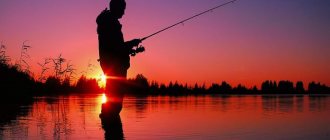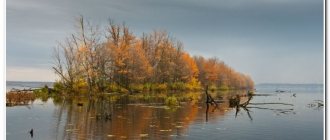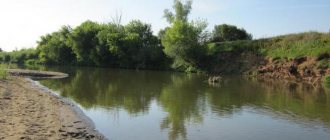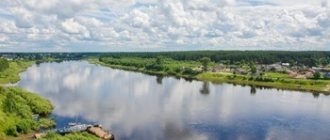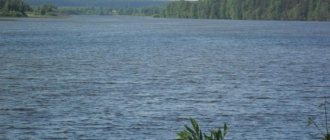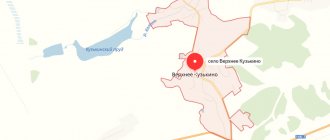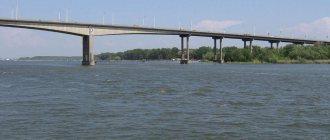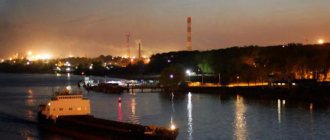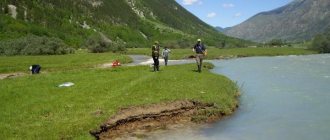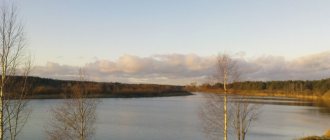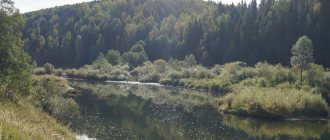One of the largest rivers in Russia, flowing through the Saratov region, Penza, Voronezh and Volgograd - Khoper. It is also the largest tributary of the Don. The Khopra basin is estimated to be more than 61,000 km long and almost 1,000 km long. The width varies within a hundred meters, the depth in some places reaches 17 meters. The current is quite fast, the bed is sandy. There are many sections of the old riverbed in the river valley.
Fishing on Khopra is varied and generous.
Fish wealth
In Khopra, along its entire length, there are: white-eye, pike perch, sabrefish, ide, perch, pike, catfish, chub, crucian carp, asp, silver bream, roach, bleak, etc. You can even find tench, shemaya, fishermen, bluefish, gudgeons, carp, burbot and sterlet. Therefore, fishing on Khopra is an undoubted pleasure.
The first fishermen appear on the river as soon as the spring flood subsides. It is in the last ten days of June that the first peak of the bite occurs. The second surge begins towards the end of September and lasts about three weeks. But only if there is no high water.
Fishing
The Khoper and its tributaries and floodplain lakes are a great place for fishing. You won't leave here without a catch. It is no coincidence that fishermen from different parts of our country visit Khoper.
The river is home to approximately 38 species of fish: catfish, pike perch, bream, crucian carp, bleak, chub, ide, roach, carp, pike, ruffe, silver bream, rudd, gudgeon, sabrefish. There are also rarer species: sterlet, burbot, carp, fisherman.
The conditions for fishing are also different: you can settle down as a “savage” with a tent for several days, or you can use the services of camp sites specializing in fishing. The active fishing season begins after high water and lasts until September.
Choosing a strategy
Bream goes well from a boat to a fishing rod with a float. Moreover, you need to release the float far and get into a deep riffle.
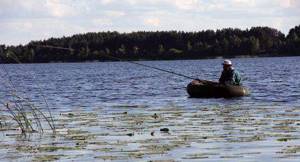
As soon as stable warm weather sets in, even in still water, fishing on the Khoper will be good near grassy banks in thickets of water lilies, at a depth not exceeding one and a half meters. Guests are not always able to find such a place on a whim. The backwater, usually full of tench, rudd and crucian carp, lends itself only to master floaters, especially if they have been feeding local fish for a long time.
Carp awaits fishermen in backwaters with silted snags. They catch it on pearl barley shells or steamed peas.
Predatory prey
Hopper and catfish abound. True, it is quite difficult to catch him. It is preferable to take catfish with live bait and donk.
Pike perch is good along the entire length of the river. It is excellently caught at the end of October–November and even later using bottom gear. There are specimens up to 7 kg. The best place is the Siskovsky farm.
The camp site on Khopra near the village of Kumylzhenskaya invites admirers of bottom gear. The only negative is that you need to re-throw it sometimes. The reason for this is the strong current, which carries sand into the feeders.
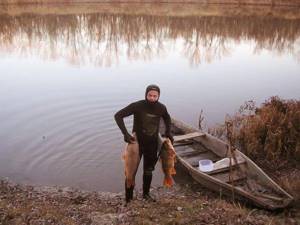
Catching asp on Khoper
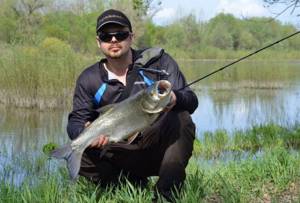
The Khoper in the Borisoglebsk region is a typical forest river. He makes a lot of loops and turns here. There are many deep, snagged areas with fast currents, many reaches and sandy rifts. The places are beautiful and airy. And there is fish here. Expanse for fishermen. Yes, there are not so many of them located along the banks, which have preserved their pristine nature. Old mowing, Dolgusha, Povorinsky stream, Filippov corner, these places have attracted lovers of silence, clean air and some old-fashioned equipment of human existence for decades. Wooden houses, each located on its own, and most importantly, excellent fishing make you come here again and again. The Khoper here is wide and deep, has many dead-end and closed oxbow lakes, snags with fast currents alternate with wide reaches and sandy rifts. There is plenty of room for an amateur fisherman to explore here.
Hunting for asp is especially interesting and successful in these places. Middle of a day. midday heat, everything calms down, most fishermen are resting after dawn, the river is empty. But this is the time of the greatest activity of the asp. There is a continuous roar on the river. It seems that asp came here from all over Khopr.
They say that large asp have long since disappeared from the rivers of the middle zone, and a fish weighing several kilograms is already considered very large. Then you will probably be surprised by the sherespers that are caught in the middle reaches of the Khopr.
All recommendations for catching asp emphasize that it is very difficult to catch it, that it is very cunning and careful. There is some truth in all this, but that’s all. Of course, it is much easier to throw a donk, lie down on the shore and wait for the bell to ring, than to constantly look for a convenient place to cast a spoon in extreme heat, or, with difficulty maintaining balance on a half-submerged tree trunk, make dozens of casts.
Personally, I believe that the whole difficulty in hunting asp lies in the inaccessibility of its habitats. Snags, strong currents, and the dynamics of what is happening often make it impossible to make an accurate cast.
The asp simply does not see or feel the vibrations of the quickly moved bait. There were cases when an asp quickly pursued a lure and, having missed several times, grabbed it close to the shore.
The shapes and sizes of the spinners used are not particularly important. It happened that a small spinner, which was designed for catching a small perch, was grabbed by an asp weighing several kilograms, and an asp weighing a little more than half a kilogram took a spinner, which would have been too big for a large pike.
Like any other predator, the asp, hunting for small fish in a fast current in a seething stream, is guided only by the organs of vision and the lateral line and does not notice the spoon, does not feel its vibrations, since the usual bait has to be placed at some distance from the asp’s parking place ( in snags, branches, sunken logs, etc.).
You can literally slip a spinner under the nose of an asp standing in ambush, avoiding getting caught with an almost one hundred percent guarantee. The bait has a shape typical of the Wonderful spinner. It is equipped with a double hook, which is attached to the body with a special latch spring.
Thrifty Khoper in the Volgograd region
Here the territory of the river is limited by the Khopersky Nature Reserve. Therefore, fishermen must follow some rules.
- Fishing from the shore can only be done with a fishing rod or spinning rod on sand spits.
- Only small rowing vessels are allowed in the protected area.
- In the protected area (55 km) you can fish for no more than three days.
- The vessel is allowed to stop in specially designated areas.
What kind of fish is caught in Khopra in July? The predator is doing well. In the area of the village of Tepikinskaya there are silted dams with large riffles and submerged snags. It is difficult to get to the shores in this area due to the dense forest, but there are no restrictions on fishing.
Bream is caught here at dawn or at sunset until July 15-20. You need to choose a place that is steep, but calm. The best bait for bream is bran, cake or cottage cheese. The bait, which is best kept at the bottom, is worms or peas.
Ide is caught later - at the end of August - beginning of September.
Any camp site on Khoper has a specialist who knows where to catch catfish. But it is well known that they go after catfish at night, preferably dark. Bait: live bait, earthworms and frogs.
Towards the end of August, burbot and tench begin to bite. They love quiet backwaters with thickets of reeds and coastal grasses. A dung worm or bloodworm is used as bait and fed with cottage cheese. The float must be very sensitive.
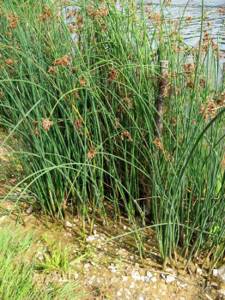
Morning fishing on the Khoper River in the Voronezh region throughout the summer - favorite pike perch, perch and pike. They bite on the lure. In recesses with pressure flow, you can drag them on a simple hook.
My river Khoper

A little from the wiki. Khoper is a large river in the Penza, Saratov, Voronezh and Volgograd regions of Russia, the largest left tributary of the Don. Length 980 km, basin area 61,100 km². The food is predominantly snowy. High water in April - May. The highest water flow is 3720 m³/s, the lowest during low water is 45.4 m³/s, the average water flow is 150 m³/s. It freezes in December and opens in late March - early April. In some years, ice cover is unstable. Width up to 100 m, depth up to 17 m. The bottom is usually sandy; The current is fast. In the valley of Khopra there are many old women. There are many species of fish in the river: pike perch, ide, sabrefish, catfish, pike, perch, bream, crucian carp, asp, chub, roach, silver bream, bleak, dace, kalinka, white-eye, podust, and others. Sterlet, burbot, tench, carp, gudgeons, bluegills are rarely found; shemaya and vimba come in. Moose, hares, gray herons, swans, eagles, falcons, owls, nightingales, ducks, beavers, river turtles, snakes (snakes and vipers), etc. are found near the river. The Khoper originates in the central part of the Penza region, within the Volga region uplands, flows through elevated areas in a southwestern direction, flows into the Don near the village of Ust-Khopyorskaya. Khopyor is navigable (from the city of Novokhopyorsk, 323 km from the mouth). Motor ships “Comets”, ferries, and barges sail along the Khopr River. A pontoon bridge was installed in the village of Fedoseevskaya from 1955-1957. Since the late nineties, due to the construction of bridges, shipping has been cancelled. Along the entire route of the river, bridges reach a height of 18-26 meters. A significant part of its length is accessible for kayaking. On the river are the cities of Balashov, Povorino, Borisoglebsk, Novokhopyorsk, Arkadak, Uryupinsk. The Khopra Valley was one of the places where the Don Cossacks settled. In the Khopra Valley, back in the middle of the 20th century, reserves with rich flora and fauna were organized - Almazovsky, Khopyorsky, Arkadaksky. In these reserves the following are protected: fox, river beaver, muskrat, wild boar, brown hare[2]. In the lower reaches of the river, in the area between the cities of Borisoglebsk and Novokhopyorsk, there is the Khopyorsky Nature Reserve.
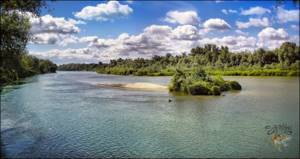
The beginning of hydrological research of the river. Khoper was founded in 1892-95. Don description party of engineers Chertsov and Rosenvert on behalf of the Ministry of Railways and Communications. However, the functioning of the first hydrological post on the Khoper began even earlier: 1876-78... In the Soviet years, a comprehensive study of the Khoper was undertaken in 1930 by the State Institute for the Design of Water Protection Structures (Giprovod) as part of work on the problem of the Upper Don. In the 30s XX century There were 16 hydrological stations on the river. Even then, a low average annual turbidity of the river was noted - 70 g/m3; the hydrochemistry of the river at that time was poorly studied.
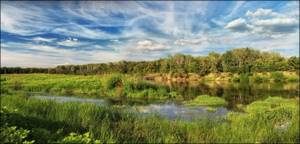
Despite the far from ideal statistics describing the water quality in the Khoper, in the scientific literature and especially in media reports, the Khoper is called “the cleanest river in Europe”, “the cleanest river in the south-east of Russia”, “one of the cleanest rivers of the steppe zone of European Russia ", "one of the most beautiful rivers in south-eastern Russia", "a unique and cleanest river in Europe." These assessments are not unfounded. The Khoper is the only unregulated river in the forest-steppe of the Russian Plain. Hydrological processes occur naturally, becoming the basis for the naturalness of dynamic changes in the abiotic component of the landscape, as well as its flora and fauna. The nature of Prikhoperye is of global importance. There are 4 key bird territories (IBAs) of international importance in Prikhoperye: in the Tambov region: Voroninsky State Nature Reserve, Vorono-Khopersky ITA; in the Voronezh region: Khopra floodplain near lake. Ilmen, Khopyorsky State Nature Reserve. In the Voronezh Prikhoperye region, protected areas of regional significance include natural monuments: lake. Ilmen (the largest lake in the region), Mokroe swamp (Povorinsky district); Khopyorsky State Nature Reserve, Alkhi tract, park-estate c. Kalinovo, Krasnyanskaya steppe, nameless swamp (Novokhopersky district); natural monuments: section of the river Savals (Saval forestry), Upper Karachan, Golden Fund, “Taiga Women” alley, Pets of Centuries, Demidov Log tract (Gribanovsky district). Scientific expeditions of various statuses, carried out to study Khoper in recent years, indicate not only the need for an integrated approach and the implementation of new environmental projects in the Khoper region, but also the uniqueness and originality of the Khopra ecosystem, unique landscapes, species diversity], changes in the content of substances in river water when moving from the headwaters (cleaner water) to the mouth (less pure), about changes in biodiversity along the Khopr with movement from the forest-steppe zone to the steppe zone, about the richness of the territories adjacent to the Khopr in historical, architectural and archaeological monuments, most of which have not been studied specialists, etc. Thus, the naturalness of the hydrological regime of Khopr, the richness and diversity of the water fund, the dynamism of its hydrological conditions, naturally is the basis for the wealth of biodiversity of its ecosystems, which need further research and protection.
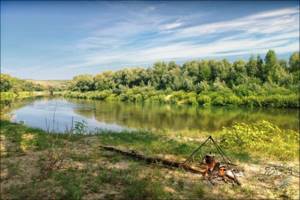
A couple of legends about the Khoper River... According to legend, old man Khoper lived in these places. He was walking along the steppe and saw 12 springs coming out of the ground. The old man took a shovel and connected all these springs into one large stream, on which he built a mill and ground grain here for peasants from the surrounding villages. And the river was then given the name of its creator. At the source of the Khoper River near the village of Kuchki, Penza District, Penza Region, a monument “Old Man-Khoper” by sculptor Andrei Smely was erected.
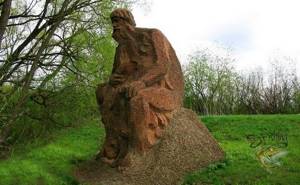
Another story tells us about the love of the Slavic youth Khopr and the daughter of the Polovtsian khan, the beautiful Vorona. In ancient times, when tribes roamed the feather grass steppes from the Volga to the Dnieper, and Mordovian villages were hidden in dense forests, the Polovtsian Khan Tokay had a daughter, the beautiful Crow. Swift, dexterous, beautiful, slender with blue-black hair. Polovtsian and Mordovian youths often dreamed of the crow. But the evil Tatars attacked the land, killed the brave Polovtsian youths, plundered the Polovtsian huts, and captured young and old. Only one Crow managed to escape. The Tatar warriors chased after her. The girl sought protection from the Mordovians. But they, frightened by the pursuit, went into impenetrable forests. The dexterous and brave young man Khoper from the Slavic tribe of Vyatichi saw the Crow. At full gallop, he picked her up, put her on his horse and rushed to the gray-haired Don, seeking protection. And the pursuers are getting closer and closer. The gray Don waved the river blanket and turned fugitives and pursuers into rivers.
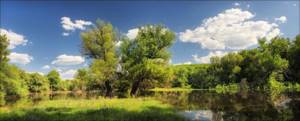
A little bit of history... But it’s up to you to judge whether it’s true or fiction. It is believed that the Khoper is one of the largest tributaries of the Don. However... “The Khoper channel is one of the most ancient river systems in the world. According to the latest data, the age of the paleochoprus is estimated at approximately 10 million years of existence. But the modern Khoper is a river with an age of 10 thousand years (approximately), which gives it the right to be called the most the old river of our region. After all, both the Volga and Don are at least half as old. Hence the assumption that our Khoper is, in principle, a dying river, no matter how sad it may sound. If anyone is interested in the details, then I can post in more detail. In general, summing up the Khoper is degrading, and not only from anthropogenic impact, it’s nature...”
2012-09-23
“The Origins of Khopr” Penza Narrated by V.I. Lukyanov
Liked: 3, disliked: 0.
Total views at the time of publication: 1329
In their free time, someone goes to the sea, swims and sunbathes, someone goes to the mountains, someone dreams of Karelia or Siberia, someone... For me, Khoper will always be my favorite place. No. I don’t want to say that I would refuse to visit Siberia or mountain streams. But for me, my river has not yet been explored, I have not been everywhere. But I think there is still more to come. You can talk a lot about the river, about its beautiful banks, rifts and holes, aquatic inhabitants, and the animal world inhabiting the banks of the River. But still it must be seen. Thank you for your attention.
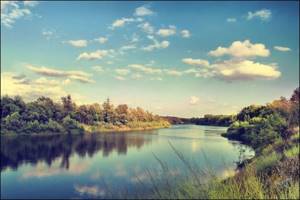
2013-10-15
Source of Khopra.
Liked: 3, disliked: 0.
Total views at the time of publication: 316
Khoper in the Penza region
Most of the fishing spots here are in the lower reaches. The best of them are located closer to the border with the Tambov region, in the Bekovsky district. The depth in the recesses reaches eight meters. And even oxbow lakes delight you with fish, especially tench and crucian carp.
Fishing on the Khopra in the Penza region will be rich in chub, asp, roach, pike, perch, silver bream, saberfish, and ide. A little less often you can catch carp, burbot and catfish.
The end of May-beginning of June, when the water has not yet completely receded and the oxbow lakes are connected by channels, is the time for fans of spinning rods. If you choose the right bait and tackle, the catch of white fish will be huge. Next comes the season of predators. It's easier to catch him here. In small backwaters there is no current as such, so they are not overgrown with reeds and grass and do not break off gear. They catch chub, pike, catfish and the like with poppers, spinnerbaits and spinner baits. The latter, together with shallow-water wobblers, make it possible to catch a good asp (up to three kg). It prefers flooded bushes and snags.
Fishing on the Khoper, especially on the high banks, is rich in pike perch. After spawning, it rests in thickets of grass and reeds until the bleak goes to spawn. At this time, pike perch is caught on various pieces of rubber and small wobblers. But for this you need to know the depth of the fish. Therefore, it is easier to use rubber baits.
Geographical information
The Khopyor River originates near the village of Ivanovka in the central part of the Penza region of the Volga Upland and flows through elevated terrain. The river bed is directed to the southwest. After covering a distance of about 980 km, it flows from the left side into the Don River near the village of Ust-Khopyorskaya.
The length of the river is 980 km, the basin area is 61,000 km². The river bed is very winding. The width of the channel in the middle reaches varies from 20 to 35 m, and below the river mouth. Crows - increases to 50-60 m. In the lower reaches, the width of the channel reaches 200 m (with depths up to 8 m), the greatest depth is about 17 m. The width of the valley increases from 2 to 8 km in the middle reaches of the river and up to 10-20 km - in the bottom. There are many oxbow lakes and channels on the vast and sometimes swampy floodplain.
Food mainly consists of precipitation. The flood begins in the spring months. Covered with ice in December, ice drift begins at the end of March and April.
The main tributaries of the river: Vorona, Savala, Karachan, Karai, Olshanka, Iznair, Kamzolka, Kolyshley, Mitkirey, Serdoba, Tamala, Pyasha, Kumylga, Buzuluk, Tishanka, Akulovka.
The main cities on the river: Arkadak, Balashov, Borisoglebsk, Povorino, Novokhopyorsk, Uryupinsk.
Camp sites
There are many tourist bases along the entire length of Khopra. Almost all of them are located in unique places.
One of the favorites of fishermen is the “Tour Center on the Cherkasy Backwater”. The depth of Khopra here reaches ten meters. The backwater is divided into two branches: one smaller with an overgrown bed, the other clean with springs at the bottom.
Conditions at the base are Spartan. All amenities are outside. You can cook food on a gas stove or grill. There is a common refrigerator for several houses. By the way, they are double. But here there is always silence, peace and easy breathing.
Frequent guests of the Old Mill recreation center know what kind of fish is caught in Khopra in July. It is located in the Saratov region, Balashovsky district. The camp site is designed for recreation by large groups or families. Fishermen here prefer boat fishing.

In the Volgograd region, the recreation center "Khutorok" awaits fishing enthusiasts all year round. The houses here accommodate a maximum of five guests. Three meals a day (optional). There is a motor boat rental service at the base.
